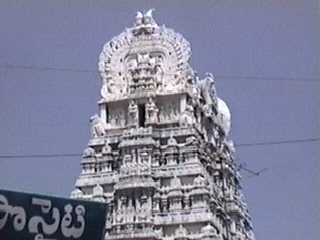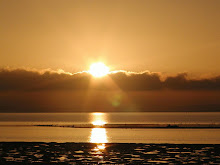Vaikunta Ekadasi Celebrated On January 7th 2009..
The most important festival of the year especially for Vaishnavites all over the world is VaiKunta Ekadasi which is an important festival dedicated to Lord Vishnu in the Tamil Month ofMargazhi (Dhanur Masam) which falls on Wednesday, January 7th, 2009.
Vaikunda Ekadasi festival is of great significance at the Tirupati Balaji Temple at Tirumala, Srirangam Sri Ranganatha Temple and at the Bhadrachalam Temple.
The significance of Vaikunta Ekadasi can be traced back to the Padma Purana. The Purana indicates that Lord Vishnu took the form of “Ekadasi” – female energy – to kill demon Muran. This happened during the month of Margazhi. Impressed by “Ekadasi,” Lord Vishnu told her that whoever worships him on this day will reach “Vaikunta”.
It is said that the Divine Gates to the heaven open - the Gate of Vaikuntha - on the Vaikunta Ekadasi day. It is one of the most auspicious days in Lord Vishnu Temples in South India .
The “Vaikunta Dwaram” or “the gate to the heaven” is opened on this day. This is the passage encircling the innermost sanctum of the Lord. Scores of devotees queue up to pass through the Gate of Vaikunta in the temples.
Sri RANGANATHASWAMY Temple, Srirangam, Vaikunta Ekadasi celebrations in Srirangam in Tamil Nadu - foremost of Vaishanvite Shrines, lasts 21 days and is divided into two parts of pagal pathu (morning part) and Ira pathu (night part). Lord Vishnu as Lord Ranganatha is adorned is an armor of diamonds (rathnaangi) and is brought to the Thousand-Pillared Hall from the sanctum sanatorium through the northern gate known as Paramapada Vasal, the gate to the heaven. This gate is opened once in a year, only on the Vaikuntha Ekadasi day.
TIRUMALA Venkateswara Temple in Andhra Pradesh also has a similar concept. Thirumala has a special entrance called Vaikunta Dwaram that encircles the sanctum sanatorium. The dwaram (passage) is opened only on Vaikunta Ekadasi and it is believed that any person who passes through this `Vaikunta Dwaram’ on this particular day attains salvation. The temple witnesses heavy inflow of pilgrims and dignitaries for Vaikunta Ekadasi. There will be a sea of people at Tirumala in the first week of January every year.
BHADRACHALA RAMA TEMPLE in Andhra pradesh on the banks of Godavari river which is unique Sri Rama temple where Sri Rama is seen with four arms and Sita Ma sitting on His left lap. Vaikunta Ekadasi is also celebrated here in the grandest fashion. Those of you who would like to know about Bhaja Govindam in detail, please click the link below to read or recite Bhaja Govindham on the sacred day of Vaikunta Ekadasi : Link.
Those of you who are busy people can watch about 11 minutes to watch, listen & English meaning of Bhaja Govindham by no other than the Legend, The Queen of Carnataka Music, Late MS SubbaLakshmi (MS Amma) is a delight to our eyes and ears on this holy Vaikunta Ekadasi Day is a MUST. Please click the link below to enjoy during the two hours of the Maha Yajnam on January 7th : Link.
It is also highly desirable to recite or listen Sri Vishnu Sahasra Namam on Vaikunta Ekadasi especially during the 2 hours of Maha Yajnam on January 7th by clicking the link below : Link.
And finally for those devotees who are keen to recite all the 1000 names and their English meaning during Vaikunta Ekadasi, please click the link to recite : Link.
Let us all Celebrate this wonderful Vaikunta Ekadashi day by Praying to Our Beloved Lord Sai to grant us the strength to spread His Divine Mission and Message to many of other parts of the world.
Om Sai Ram
Source: from the Internet
Vaikunta Ekadashi (alt: Vaikunta Ekadasi - Vaikuntha Ekadasi - Vaikuntha Ekadashi) is the Ekadashi that occurs in the Hindu calendar month of Marghazhi or Margashira or Margasirsa (corresponding to late December - January in English calendar). Vaishnavism (Worship of Lord Vishnu) culture believes that ‘Vaikunta Dwaram’ or ‘the gate to Lord’s Inner Sanctum’ is opened on this day. The Margashirsha shukla paksha ekadashi in lunar calendar is known as a ‘Mokshada Ekadashi’. People also know that as a vaikunta ekadashi. However vaikunta ekadashi in Sri Rangam Temple (Tamilnadu) is in the solar margashira month (Margazhi). Special prayers, yagnas, discourses and speeches are arranged at Vishnu temples across the world on this auspicious day.
According to the Vishnu Purana, fasting on Vaikunta Ekadashi is equivalent to fasting on the remaining 23 Ekadashis of the (Hindu) year.
It is said that Vishnu opened the gate of Vaikuntam (his abode) for two demons although they were against Him. The demons asked for the boon that whomever listens to their story and sees the image of Vishnu coming out of the door (called Vaikunth Dwar) will reach Vaikunth as well! Temples all over the India make door-like structures on this day for devotees to pass through.
According to the Padma Purana, the female energy of Lord Vishnu slew the demon Muran to protect the Devas. Lord Vishnu named her `Ekadashi’ and gave her the benediction that those who worship Her on the day of her victory over Muran would reach `Vaikunth’ (His abode).
In the Mahabarata, Bhagavad Gita - the conversation between Lord Krishna and Arjuna at the beginning of Kurukshetra War is said to have occurred on this day.
Sathya Sai Baba Speaks About Vaikunta Ekadasi (also known as Amrithodbhavam Day - Mokshada Ekadasi - Nanjunda Ekadasi)Today is the day when, during the saagara mathana (churning of the ocean), Amritha (nectar) emerged and was distributed to the Gods. The Gods had slid into the calamity of lowering their immortality! Man too is the child of immortality; that is the reason why he cannot force himself into the conviction that he would die.
Resolve on this auspicious day to enter upon the quest of Truth. Uttarayana is Uttama Kala (the best time). For the morning of this day, the great Bhishma waited long on his bed of arrows. On this morning the sun turns north, the direction of the Gods, where Siva resides. The Sun is the deity that controls the eye, the vision of man, and so these six months when the sun is proceeding in the direction of Siva, are very propitious for man to do likewise.
Today, it is also VAIKUNTA EKADASI. Many of you expect Me to go to the Chitravati riverbed and create nectar and give it to all. You have earned the vaag-armitam (nectarine speech), from this discourse, which you can treasure in your minds and act upon. This is the real Heavenly Nectar. Know its worth. Do not allow it to be wasted, garner it to become Godly.
In order to make people understand their real Divine nature, festivals were designed. Today is Vaikunta Ekadasi. What is Vaikunta? “Vaikunta,” as the abode of god, means a place which is changeless. Many things may change in a man, but his heart is changeless. What is meant by Ekadasi? This should not be regarded as some special place or time. The form of Ekadasa Rudra is made up of the five organs of perception, the five organs of action and the mind. Rudra is a resident of the human body, which is full of numerous potencies. Men today are forgetful of these potencies and the divinity that dwells in the heart.








 KALAHASTI is a town in the Chittoor District of Andhra, and it is a Railway Station on the Renigunta-Gudur section. It has a temple dedicated to Lord Siva, and is famous throughout Andhra as a sacred place and a place of pilgrimage. This religious centre, which is situated between two steep hills, called Sripuram and Mummidicholapuram, is said to have formed part of Seshasaila or Mount Meru, in the ancient days.
KALAHASTI is a town in the Chittoor District of Andhra, and it is a Railway Station on the Renigunta-Gudur section. It has a temple dedicated to Lord Siva, and is famous throughout Andhra as a sacred place and a place of pilgrimage. This religious centre, which is situated between two steep hills, called Sripuram and Mummidicholapuram, is said to have formed part of Seshasaila or Mount Meru, in the ancient days. KALAHASTI is a town in the Chittoor District of Andhra, and it is a Railway Station on the Renigunta-Gudur section. It has a temple dedicated to Lord Siva, and is famous throughout Andhra as a sacred place and a place of pilgrimage. This religious centre, which is situated between two steep hills, called Sripuram and Mummidicholapuram, is said to have formed part of Seshasaila or Mount Meru, in the ancient days.
KALAHASTI is a town in the Chittoor District of Andhra, and it is a Railway Station on the Renigunta-Gudur section. It has a temple dedicated to Lord Siva, and is famous throughout Andhra as a sacred place and a place of pilgrimage. This religious centre, which is situated between two steep hills, called Sripuram and Mummidicholapuram, is said to have formed part of Seshasaila or Mount Meru, in the ancient days. 36 kms from Tirupati Via Renigunta Junction.
36 kms from Tirupati Via Renigunta Junction. Tirupati (30km) is the nearest airport and is perhaps the most convenient base for visiting Kalahasti as it (Tirupati) is endowed with several modern lodging facilities. A one day trip from Chennai is also possible, as Kalahasti is well connected by road with Tirupati and with Chennai and is only a four to five hour drive from Chennai. If well planned, Tirupati, Tirumala and Kalahasti can be covered in a day's trip from Chennai by car.
Tirupati (30km) is the nearest airport and is perhaps the most convenient base for visiting Kalahasti as it (Tirupati) is endowed with several modern lodging facilities. A one day trip from Chennai is also possible, as Kalahasti is well connected by road with Tirupati and with Chennai and is only a four to five hour drive from Chennai. If well planned, Tirupati, Tirumala and Kalahasti can be covered in a day's trip from Chennai by car. Papavinasam waterfalls, Akasaganga waterfalls, Narayanavanam, Perumallapalli, Nagalapuram, Talakona, Kamipakam.
Papavinasam waterfalls, Akasaganga waterfalls, Narayanavanam, Perumallapalli, Nagalapuram, Talakona, Kamipakam.
